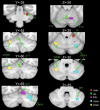Cerebellar contributions to visuomotor adaptation and motor sequence learning: an ALE meta-analysis
- PMID: 23403800
- PMCID: PMC3566602
- DOI: 10.3389/fnhum.2013.00027
Cerebellar contributions to visuomotor adaptation and motor sequence learning: an ALE meta-analysis
Abstract
Cerebellar contributions to motor learning are well-documented. For example, under some conditions, patients with cerebellar damage are impaired at visuomotor adaptation and at acquiring new action sequences. Moreover, cerebellar activation has been observed in functional MRI (fMRI) investigations of various motor learning tasks. The early phases of motor learning are cognitively demanding, relying on processes such as working memory, which have been linked to the cerebellum as well. Here, we investigated cerebellar contributions to motor learning using activation likelihood estimation (ALE) meta-analysis. This allowed us to determine, across studies and tasks, whether or not the location of cerebellar activation is constant across differing motor learning tasks, and whether or not cerebellar activation in early learning overlaps with that observed for working memory. We found that different regions of the anterior cerebellum are engaged for implicit and explicit sequence learning and visuomotor adaptation, providing additional evidence for the modularity of cerebellar function. Furthermore, we found that lobule VI of the cerebellum, which has been implicated in working memory, is activated during the early stages of explicit motor sequence learning. This provides evidence for a potential role for the cerebellum in the cognitive processing associated with motor learning. However, though lobule VI was activated across both early explicit sequence learning and working memory studies, there was no spatial overlap between these two regions. Together, our results support the idea of modularity in the formation of internal representations of new motor tasks in the cerebellum, and highlight the cognitive processing relied upon during the early phases of motor skill learning.
Keywords: cerebellum; meta-analysis; sequence learning; visuomotor adaptation; working memory.
Figures



References
-
- Anderson J. R. (1982). Acquisition of cognitive skill. Psychol. Rev. 89, 369–406
Grants and funding
LinkOut - more resources
Full Text Sources
Other Literature Sources

